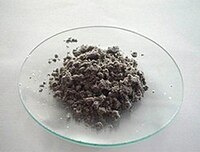
Photo from wikipedia
Abstract A self-consistent thermodynamic description of Y–H binary system has been derived using the CALPHAD method with the aid of first-principles calculations and applied in the fabrication of crack-free bulk… Click to show full abstract
Abstract A self-consistent thermodynamic description of Y–H binary system has been derived using the CALPHAD method with the aid of first-principles calculations and applied in the fabrication of crack-free bulk Zr–Y hydride neutron moderator. The enthalpies of formation of the end-members calculated by first-principles were adopted for the thermodynamic assessment. Only four model parameters were needed and optimized with the available experimental data from literature. The calculated phase equilibria and thermodynamic data agree well with experimental data. Y–Zr–H ternary system was constructed by extrapolation of three binary sub-systems. According to the thermodynamic calculation results, the hydrogenation of Zr–Y alloys was divided into three stages: isothermal hydriding, isobaric hydriding and terminal hydriding. By carefully controlling the temperature and hydrogen pressure, the transformation from metal to hydride of yttrium and zirconium can be separated and carried out in different stages, so that the cracks formation during hydrogenation was successfully inhibited. With addition of yttrium, the stress induced by the martensitic transformation from δ to e zirconium hydride would be relaxed. As a result, hydride embrittlement can be mitigated, and the bulk Zr–Y hydrides without micro-cracks can be fabricated.
Journal Title: Journal of Nuclear Materials
Year Published: 2020
Link to full text (if available)
Share on Social Media: Sign Up to like & get
recommendations!